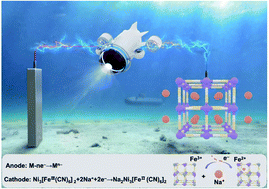A high-power seawater battery working in a wide temperature range enabled by an ultra-stable Prussian blue analogue cathode†
Abstract
Seawater batteries have been widely used for the marine technology industry. However, elevating the output power density of seawater batteries to achieve long term and repeated underwater usage in a wide range of environmental temperatures remains a challenge. In this work, a seawater battery with ultra-high power density and ultra-stable cycling performance in seawater from 0 °C to 40 °C has been realized by using a metal as the anode and nickel hexacyanoferrate (NiHCF) as the cathode. The electrode made from NiHCF increases the output voltage of the seawater battery and shows almost no capacity fading at high current density during cycling. As a result, the seawater battery presents a high power density of over 160 mW cm−2 and can work stably in seawater in a wide temperature range (0–40 °C). Experiments have proved that the seawater battery system could drive the target electric boat in an actual marine environment. This result proved that the seawater battery could potentially be applied to marine equipment.



 Please wait while we load your content...
Please wait while we load your content...